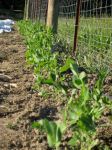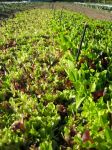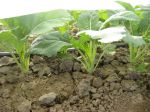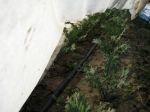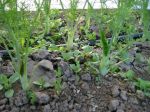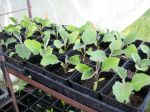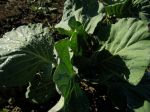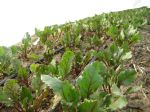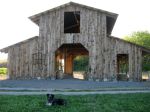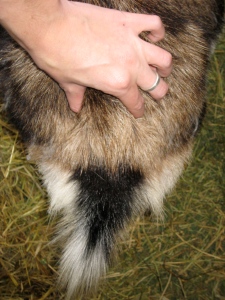About a week ago I snapped some photos of the little plants that are sneakily growing into big plants in rows and fields around the farm. If you’re in the mood for a scavenger hunt, you can sift through the photos and see if you can identify the various vegetables in their teenage phases. Below you’ll find: cabbage; broccoli; beets; kohlrabi; fennel; baby salad greens; head lettuce; peas; tomatoes; eggplant; garlic; onions.
Category Archives: Farming Info
The Waiting Game
Did you ever play the Waiting Game as a kid? It was one of those games generally forced upon children by short-tempered parents, like the Quiet Game or the Use Your Restaurant Voice Game, and in the same class as the Clean Plate Club (a club which typically required your membership only when your plate sported broccoli or spinach). In other words, not very fun.
Unfortunately, it turns out the Waiting Game isn’t just for kids. It’s also for goat owners awaiting kids.
We moved expecting mama Emily into a comfy, plush kidding stall inside the barn on Friday morning, thinking she was due on Valentine’s Day (Sunday). We pulled out all the stops for our mother-to-be: put down soft, fresh straw for her to lie on, rigged up a pen out of hog panels (perfect for goat back-scratching), gave her her own personal alfalfa feeder, grass hay feeder, mineral feeder, water bucket. We threw open the windows and doors when it was sunny to let in light and fresh air and shut them as soon as it cooled down to keep the barn as warm as possible. I checked on her constantly, waking in the middle of the night and trudging to the barn to check on her, to try and make sure that we’d be there to help her out no matter what time the kids decided to arrive.
Well, it’s Tuesday, I haven’t slept more than a few hours straight in 5 nights, and Emily has shown exactly zero signs of imminent labor.
Her ligaments (the ones that run from her pinbones to her tailhead and disappear before labor) seem to soften and then firm up and then soften again, teasing me.* Her udder is continuing to fill slowly, but isn’t anywhere near full, and hasn’t shown the sudden 24-hour ballooning that typically precedes labor. Her teats seem to be starting to swell… but then again, no. Her hips seem a bit hollowed out, her belly seems to be sitting lower (indicating the kids are moving into place to make their entry into the world)… but then again, maybe that’s just wishful thinking. She has a very tiny bit of mucus discharge but nothing like the large amounts that indicate the loss of the mucus plug and the onset of labor.
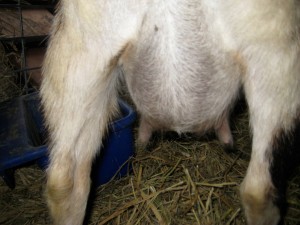
Emily's udder is filling up, but isn't yet tight and shiny. Her teats aren't filled with colostrum, either.
In other words, we have no idea when she’s going to kid! We bought her bred from Brandywine Farms (a wonderful family farm in the foothills of the Sierra), but the breeding date wasn’t known precisely, and when Emily was ultrasounded, the vet wasn’t exactly sure how far along she was. They gave a window of 15 days, the first possible due date being Valentine’s day.
So for now, back to the waiting game. And hoping that Emily will let me get some sleep before March!
——-
*FYI, signs that a goat is close to labor are:
- Loss of ligaments — specifically the ligaments along the back end of her spine, past the pin bones but before the tailhead — to the point where you can almost reach around the spine.
- “Hollowing out” of hips and a “mushy” hind end as babies drop into place and all other muscles relax to let the birth canal open up and the uterus get to work.
- Udder is tight and shiny, filled with fresh colostrum.
- Teats are swollen, taut, and full of colostrum, ready for babies to suckle.
- Mucus discharge… aka “string of goo” from the goat’s vulva.
- Goat may start to talk to babies (arching head backwards and nickering to stomach). Goat may paw the ground to try and make a nest for kidding.
- Some more subtle signs are “going posty,” which is when the doe starts to walk sort of funny and the back legs look stiff and post-like. Also, the tail will arch in a funny way.
- And of course, the biggest signs that a goat is going into labor are… contractions! And then, of course, the appearance of two little hooves, and the kid.
Filed under Farm Beauty, Farm Tales, Farming Info, Uncategorized
falcons as starling control
(When the Barbary tiercel — a subspecies of the peregrine — looks the other way, the dog drinks his water.)
Instead of using traps, mylar strips, or plastic netting, Huntington Winery in Healdsburg hires a wonderful man named Jim to fly his falcons around the vineyard. The very presence of his birds keeps starlings at bay. (BTW, starlings are a 200-million-strong invasive species which threatens all sorts of crops from berries to orchards to grapes.)
I know PETA types might raise their hackles over falconry. They don’t like the Iditarod, either. But, first off, both of these things (falconry and Iditarod) are really, really cool — the type of adventurous pastime that manages to inspire wide-eyed young children and scowling cynical adults alike. Secondly, I happen to find a working relationship between man and animal wholly respectable — the animals are truly doing what they love in both cases — and after spending time with falconers and mushers, I’d be hard-pressed to name folks who love their animals (birds and dogs) more.
Anyway, a story about falconry in vineyards (written by yours truly) will run in the New York Times Windsor Times today. Before you get the chance to pick up the paper, feast your eyes on these beautiful birds:
Above, the falcon is exhibits a behavior known as mantling — covering her “prey” after a “kill.” In this case, the prey is a lure (swung on a rope by the handle on the lower left), and no killing actually took place.
Below, Strega the Lanner Falcon, and beneath her, Ros the Saker Falcon.
OK, enough gawking. Back to the farmy stuff: stay tuned for the next post on Foggy River.
Filed under Farming Info
growing fancy: chioggia beets

Farmflash:
- Food = Expensive.
- Kenya questions value of organics. (But did the study they cited test pesticide residue, or just nutritional content?)
- Even England (not exactly renowned for its cuisine, and I say this with all due affection for roast beef and Yorkshire pudding) is jumping on the local food bandwagon: an author solicits help for a book about local food in Leicestershire.
- The Times features salt potatoes, an upstate classic — among other local Finger Lake faves.
Growing fancy: Chioggia Beets
I’m going to make an effort to post about some unique veggie at least once a week, with more details than I’ve previously given. For the newly-revised “Growing Fancy” section, expect to learn about the veggie’s history, nutritional content, growing tips, and cooking tips, too! Take one: Chioggia Beets.
History:
Beets are thought to have originated from wild species in the Mediterranean area of Southern Europe. Their botanical ancestors have been cultivated just about as long as anything — as far as historians can tell, since prehistoric times. Those botanical ancestors are also known as chard, a bulbless beet that Aristotle wrote about in the fourth century B.C. (I’m hoping that if I keep writing about chard, maybe I’ll become extraordinarily wise and famous, too.) Early Romans ate only the greens; the root — still hard and fibrous at this point — was considered medicine and only used for treating illness.
In the third and fourth centuries A.D., Roman food writers started to babble about beta vulgaris — a plant that apparently possessed the fleshy, sweet root we’re familiar with today. (It was probably found growing in the wild and subsequently cultivated, but nobody is not too sure about that.) Anyway, not too much was written about the beet for a while after the Romans. (I harbor a sneaking suspicion that beets were largely a peasant food, and peasant diets aren’t often recorded in the history books.) Fast-forward to the fourteenth century: the beet entered European consciousness vis-a-vis written English recipes, where it clearly “took root.” (Groan.)
Linguistic note: as some of our customers have pointed out, Chioggia is technically pronounced key-oh-ghee-ah. The “Ch” in Italy is pronounced as a hard “c,” whereas an Italian “c” is actually pronounced like the English “ch.” Still, I really haven’t heard too many Americans say it this way. (I did take a year of Italian in college, but I’m going to stick to the colloquial parlance on this one.)
Botany:
Any gardener knows a beet seed when she sees it — unless, of course, it’s a chard seed. Chard and beet seeds are pretty much identical, and look a little like extraterrestrials destined for Martian soil; each “seed” is actually a multifaceted seed pod containing multiple viable plant seeds. As I mentioned before, chard and beets are closely related, and will in fact cross-pollinate with one another if given the chance. Ditto goes for sugar beets. Be forewarned: beets are wind-pollinated, and the pollen can travel great distances. If you want to seed-save and get true-to-type Chioggia beets next year, make sure your beets aren’t flowering at the same time as your chard (or at the same time as another beet variety, such as Golden or Bull’s Blood).
Interesting side note: if you leave the pods on the plant too long in a rainy season, you might find tiny little beet plants sprouting mid-air from the parent plant, like rainforest epiphytes. It’s not particularly useful, but it’s pretty cool to see!
Growing:
We follow Johnny’s Seeds’ instructions for these little guys: directly sow them one inch apart, half an inch deep. Water regularly (we drip irrigate every day). Since each seed pod will sprout multiple plants, you’ll have to do a bit of thinning pretty quickly. But since beet seeds aren’t cheap, I really try to get the most out of each sprouted seed: We wait to thin as much as possible until the greens are big enough to use in a salad (yum) — and even then we only thin them to, say, a two-to-three-inch spacing. We thin again for baby beets, which are so tender and tasty and have good-sized greens. Approximately two months after planting (depending on weather — hotter is faster, cooler is slower), the remaining beets should be nice and plump, the bulbs easily visible from the surface. (If you want a perfect-looking beet, you can mound dirt over the bulbs so the skin quality is more uniform. But when you cook it, you end up peeling off the skin anyway, so I don’t bother.)


Chioggia beets have been summering our ninety-degree days quite well, and haven’t found themselves too put out by our clay soil. While some of our other beet varieties (specifically the classic dark red variety) have suffered from mild bouts of beet scab — an unattractive but not fatal condition — Chioggia has proven more resistant. The tasty beet greens haven’t been particularly plagued by pests, either — despite the fact that they’re grown out in the open, without a row cover, in a field rife with leaf-eating cucumber beetles.
Eat It:
Roasted! This caramelizes the beet’s naturally occurring sugar (which is about 8% of the plant), bringing out the root’s innate sweetness. It also preserves the Chioggia’s striking colors better than boiling, which tends to fade the characteristic candy stripes, at least on the areas most exposed to water.
To maximize the wow factor and minimize the cooking effort, simply slice the beets in half, place them on a cookie sheet, drizzle with olive oil, sea salt & pepper — maybe some balsalmic if you feel the urge — and put them in an oven until they’re nice and tender. (Cooking length depends on size of beet.) Then simply peel the skins off and serve. (Or, like we do at our house, simply serve and warn people about the skins. Our kitchen is a do-it-yourself operation.)
Chic Chioggia:
- Doesn’t stain the heck out of everything like the classic purple beet.
- The stripes are truly stunning, especially for peppermint fans. (Also: Can trick unsuspecting kiddies with promises of ‘candy cane beet’.)
- It’s Italian, and those people really know how to cook, so chances are they developed a darn good — sweet and succulent — beet variety, too.
- A good way of getting fiber without becoming The Prune Eater; you’ll also benefit from beets’ high levels of folate and potassium. (Beets contain some calcium, too, but be sure to eat the greens for an extra dose of calcium and Vitamin C.)

Filed under Farming Info
the price of a radish: part two
Yesterday, Emmett and I ventured into the Big Apple… and stumbled across actual apples, not to mention apple cider (which we purchased and swigged straight from the half-gallon jug), apple sauce, and hundreds of varieties of non-apple fresh produce.
We were there on business, meeting with our literary agent on Fifth Ave. to finally put a face to someone we’d only interacted with via email or phone. She was the one who pointed out her eleventh-floor window down the block to Union Square, where literally thousands of customers were flowing in and out of a farmer’s market like so many tiny, hungry ants. After the meeting, we dove straight into the anthill — and were shocked at the wildly different prices we found there.
Let’s start with the radish. Our radish bunches were put firmly to shame: at the Migliorelli Farm stand, you could purchase twenty radishes for $1. (Remember, we charged $1.50 for half that many.) But the same stand was charging $2 for small and — I say this with all due affection and understanding about perishable greens and farmer’s markets lack of refrigeration — very wilted, sad-looking chard. So even if my radishes are overpriced, my chard bunches are a pretty good deal.
Perhaps the most shocking price of all could be found at Windfall Farms. (I found the name ironic for reasons that will shortly become obvious.) They were charging $6 for 1/4 pound of baby lettuce heads or mesclun mix! And $12 for 1/4 pound of arugula or mesclun with flower blossoms! I mean, sure, I’d been thinking about growing some flowers and adding them to our baby greens mix and maybe bumping the price up a buck or two. But our starting price is $3 for a bag that has at least 1/3 of a pound of greens. That means Windfall is charging 3-5 times what we charge. Even for “unconventionally grown” produce, there’s no way you could charge $12 for 1/4 lb of anything in Healdsburg and have anybody buy it. Is it just because they sell in New York? Or because they have a bit of a monopoly on baby greens at this particular market? Who knows…
There were other interesting things at the farmer’s market: dragon’s tongue beans, which are unbelievably cool looking. These guys made my purple beans feel mundane! Dragon’s tongues are flecked with yellow and purple in a psychedelic spattered-paint theme.
Other interesting items: stinging nettles (which had a sign suggesting that potential buyers handle them carefully, as they can cause itching), the foodie-chic sometimes-weed purslane, heaps of purple basil, and squash runners. The customers I talked to had no idea what to do with the squash runners, so I did a bit of research on the topic. According to the Bureau of Plant Industry, squash runners can be eaten as a vegetable. Back home, our squash plants are invading our walking paths between the rows. Instead of hacking them back and putting them on the compost pile, apparently I could be converting the runners into cash at the farmer’s market! I guess I’d better try cooking them first, because I doubt customers will buy them if I can’t suggest a good recipe…
One last humbling thought: one of the farmhands we talked to said that on a good Wednesday market day, they’d sell $5,000 worth of produce. Saturday markets can bring in $7,000. (Suffice it to say that Emmett and I are so far from even cumulatively earning $5,000, it isn’t funny.) The seller also suggested that the biggest stands can bring in $25,000 on one day — but of course they also employ something like 60 workers, so while their income is sky-high, so are their costs.
If all of this makes you want to get into the Union Square market to sell baby greens for $12 per quarter pound, good luck: getting a stall is practically impossible. It’s a very carefully-managed market, so there are are rarely more than 2 vendors selling the same specialty item. (Course, lots of folks have tomatoes and zucchini right now, but try finding multiple cider sellers or goat cheese vendors.) According to some of the farmers we spoke to, the only way to get in is: come up with something that nobody else is selling — again, good luck — or start selling at other Greenmarket farmers markets around New York (there are 46 locations, with over 250,000 customers each week) and wait, hoping that someday one of the Union Square vendors (some of whom have been selling for decades) decides to call it quits and you can sidestep in.
Filed under Farm Tales, Farming Info
pastured dairy
Yes, that’s pastured, not pasteurized.
Emmett and I are currently visiting a grass-fed dairy operation — a sustainable ag topic which, unlike pastured beef, hasn’t gotten too much media attention. While many restaurants and consumers have clamored for pasture-raised beef, organic milk seems to be the dairy of choice for the discerning, eco-oriented foodie. But if you’re really looking for a sustainable, humane milk option, grass-fed milk might be the way to go.
In a conventional dairy, cows live out their lives in stalls — stalls that are maybe eight feet by four feet (rough estimate, after seeing a barn that had been converted from a confinement operation). These ladies eat, poop, sleep, and are milked in the same space. They produce milk year-round, and are often milked three or four times per day. By contrast, pasture-raised dairy cows wander the fields in search of grass, their diet supplemented by a bit of grain — and in the winter, plenty of hay.
Pastured dairy seems a little more labor intensive, and yet in some ways it isn’t. The dairy owner’s son rose this morning at 3:30 a.m. to move the cows from the field into the barn and milking parlor. These four hundred-plus cows don’t need five cowboys to move them — just one young man and a well-designed system of lanes and small fields, all hemmed in by electric fence. The cows know the routine, too: they form a mile-long bovine line en route to the milking parlor. Once they’re finished milking, they simply go out the back door and find their own way back. They’ll saunter up the lane and go into whatever field is left open to them.
While it does take time to move the cows around the field — as opposed to simply milking them where they live — there are clear benefits to the farmer. It costs less to feed the cows, since they’re eating grass. The cows are healthier, because they’re eating grass — which is exactly the food that a cow’s 8 stomachs were designed to digest. They’re also allowed a dry time, during which they don’t produce milk. This pastured operation — located in snowy upstate New York — doesn’t move the cows into a barn in the winter. The herd overwinters outside, among windbreaks. And before you go all PETA on me about this, consider this: according to the dairy owner, a cow’s ideal temperature lies somewhere in the 40s (Fahrenheit). If the cow is well-fed, healthy, and in a herd (body heat!), it will have no problem whatsoever with snow. In my humble opinion, it’s a heck of a lot better than being stuck inside year-round — although apparently concerned tourists sometimes call to express concern over snowy cows.
Oh, and I mentioned that there are other benefits to the pastured dairy farmer. Dairy farmers work 7 days a week, with required hours from 4 a.m. – 8 a.m. and 2 p.m. – 6 p.m. That’s only the milking part; there’s obviously more work to it than that. If you let your herd dry up in the winter, you can catch up on all the stuff you’ve been meaning to do — and maybe, just maybe, take a vacation.
I’ll post some pictures when I get home and am able to upload them… and maybe give a more detailed description of how the operation works. For now, I’m off to explore the wonderful world of dairy!
Filed under Farm Tales, Farming Info
growing fancy: purple pole beans
Decorate your garden, tout your heirloom pride, and nurture your inner gourmet: grow purple beans.
When purple beans blossom, their flowers are a lovely shade of lilac. The stems are purple; the green leaves are edged in purple, too.
And boy, do these babies grow. They handily out-grew our Blue Lake Beans (a classic, tender green variety), and beat the Blue Lakes to the top of the fencing — and then, just to be sure that their victory would remain uncontested, they out-grew the fencing, too, waving several feet of vine in the air and in some cases growing back down the fence.
In terms of pests, the cucumber beetles did attack them and make lace out of their first two leaves. But they recovered quickly and put out leaf after leaf until the cucumber beetles couldn’t possibly eat them fast enough. Although our clay soil holds moisture, especially since it’s on a drip system, these guys had no problem with ‘wet feet’ — they grew splendidly. (By contrast, we found that Blue Lake was more likely not to recover from the cucumber beetle attacks, and more likely to stunt in over-wet conditions.)
The variety we grow is an Illinoian heirloom variety from Seeds of Change: Dow Purple Podded Snap. (We’ve also had success with purple bush beans, but that’s another post.)
Points for purple beans:
- Amazingly fast grower; quicker to mature than some green beans.
- Hardy: tolerant of clay soil; not finicky about water; and grows too quickly for the bugs to take over!
- Beautiful at all stages of growing: tinged purple leaves and stems, lilac flowers, deep purple beans.
- I’ve mentioned this before, but you know when these beans are done cooking: as soon as they turn green in the pan or pot, they’re good to eat. (The green they turn, incidentally, is different from a traditional green bean: these turn a slightly more blue-grey green, like a moody sea.)
- Some people don’t even realize beans come in purple. Surprise your friends with a gift of your home-grown purple beans — they’ll be delighted. (And if you plant even a short row of these beans and harvest them regularly, you should have plenty to share. NB: You’ve gotta keep picking beans for them to keep producing. If they get too big, the plant will figure that it has done its job for the year and stop trying to make seeds.)
Fast-growing, hardy, beautiful, and somehow gourmet because they’re purple, these beans are tough to beat! I give Dow Purple Podded Snap two thumbs way, way up.
Filed under Farming Info
growing fancy: beautiful baby lettuce
It’s not one hundred percent pest proof, but it’s pretty darn good. While our brassica mix attracts flea and cucumber beetles like none other — which I found interesting, since it’s considerably more spicy and slightly tougher than this mix — our awesome Johnny’s Seeds lettuce mix is surprisingly resilient and mostly beetle-free. It’s got lots of fancy-sounding varieties in it (Rouge D’Hiver, anyone?) but mostly it boils down to: curly red, curly green, (both of which are great for loft, i.e. fluffing up your salad bags), flat red and flat green. All are quite beautiful, and the “flat red” are slightly mottled — a beautiful red-and-green color blend.
Despite the summer heat — note: we water with one-foot-tall misters, but only sprang for shade cloth for a fraction of the space — the salad hasn’t yet bolted. It can easily be cut (and come again, as they say) three times without getting too tough or bitter. It takes about four weeks until it’s a harvestable size (three with lots of water and lots of heat), but regrows very quickly. I find that the flat leaves grow, and regrow, much more quickly than the curly. (Same as curly versus straight hair, I guess.)
Main thing to watch for this with this crop: weeds. (You can spot a few grasses and one wild mustard in the photo above.) But if you’re growing for home use, the weeds shouldn’t be too big of a problem — if you’re picking on the scale of one dinner at a time, you can easily pick them out while washing the leaves. For a commercial scale (even a small one), we have to spend a couple of hours a week pulling out mustards and grasses… otherwise it’s a painfully slow harvest, come Saturday morning, as we pull weeds out of each handful we snip.
One other thing to watch for, thanks to the overhead misters: slugs, which love all things damp. I’ve caught a few on the leaves, but they were really small, and I haven’t noticed too much slug damage.
Note: the organic version of this mix is called “Encore,” and the conventional is called “Allstar.” The conventional is considerably cheaper, and I think we settled for that the second time around. We always go for non-treated seeds, but I’m still torn about whether or not the seeds themselves need to be grown organically. Yes, I obviously believe in organic agriculture — but in terms of my end product, how much can one lettuce seed carry in terms of residual chemicals, etc? If the lettuce you’re eating is grown with only organic inputs, isn’t that good enough? Hopefully in the future we’ll be saving our own seeds, eliminating this discussion altogether — but it’s still some food for thought.
Filed under Farming Info
ways not to farm: part II, potatoes
I promised a post on Ways Not To Plant Potatoes, so here it is:
We dug a little trench, placed our seed potatoes at appropriate intervals, and covered them with soil. We planted these guys four inches deep, per the instructions from Seeds of Change. So far, so good, right?
Well, I guess it’s good until you have to mound them. Mounding potatoes that have sprouted at ground level is a royal pain the petutie. The whole time, you’re fighting gravity and erosion, not to mention the voluminous potato plant that has lots of airspace between its lower branches — which further fends off the mounding effort.
The first 6-12 inches of mounding was pretty easy. But after that, we found ourselves cutting a deep trench–great for tripping over, by the way–into the path just to try and get enough soil to dump on top of the potato row. We used wheelbarrows. We used shovels. We used hoes. We struggled mightily.
Next time, we are planting the potatoes in a deep trench, which we can then simply cover over–by eroding in the sides of the trench, instead of fighting erosion–as the bushes grow up. (We’ll make sure the trench is fairly wide, or at least in a well-dug bed, because potatoes have a hard time busting through compacted soil, and the potatoes tend to sprout out to the sides).
You know, I’d visited a big-scale potato farm that seemed to have their potatoes mounded up well above the surface–a good two feet, neatly done–but come to think of it, they had big gigantic machines that did that. The human labor for above-ground mounding potatoes, at least in our situation, was way too much work.
This is another of those greenhorn moments: while we’ve tended potato beds before, we’d never had to go through the whole process ourselves, from the planting to the mounding to the harvesting. From the start, it’s been an eye opening process, and I’m getting a little nervous for the finish: I can’t wait for the harvest, but I’d better not get my hopes up. Our watering has been a system of guesswork. Our soil is a tad on the clay side, although we did add manure. And while the bushes look beautiful, it’s a little scary having no idea what the crop is doing underneath the soil! Here’s hoping.
Filed under Farming Info


